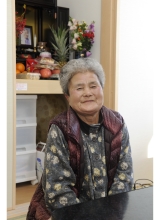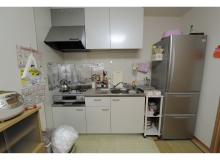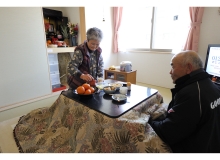SATSUKO TAKEZAWA'S STORY
2014/03/11

Safe and secure in new Red Cross home
By Francis Markus, IFRC
Since Satsuko Takezawa lost her fisherman husband seven years ago; she has followed the Japanese tradition of ringing a little bell, placed on a Buddhist shrine in her home, to communicate with his spirit. But in the cramped prefabricated house with paper-thin walls, in which she lived until a few months ago, the neighbours would often comment on the sound, making her feel stressed.
“Here, the sound insulation is good, so nobody can hear it and I feel much calmer,” says Satsuko, 73, as she sits at a table in the community room of a Red Cross supported housing project in Soma, Fukushima Prefecture.
Satsuko is one of nearly 30 elderly residents who recently moved into the homes. “I feel safe and secure here now, “ says the frizzy-grey haired woman with rosy cheeks.

Proper kitchen
After her house near the Fukushima coastline was destroyed by the tsunami, she spent more than two years living in the prefab. “The kitchen was so tiny, it is good to have a proper sized kitchen again,” she says. In it, she is still able to use the fridge-freezer and other electrical appliances donated by Japanese Red Cross Society to more than 138,000 households in temporary shelter.
Her new home is in one of only a small number of permanent housing developments to have been built so far – largely by the government, which has said it has the capacity to handle reconstruction without large-scale involvement by the Red Cross. The process of reaching consensus within communities on where to build and the difficulty the government faces in acquiring land for construction have been major factors slowing down reconstruction.
“Many people from the temporary housing settlement would like to move in here,” says Satsuko. But because the number of places was limited, only those elderly from the local community, over 65, and living apart from their children, could be considered.

Ageing population
Given Japan’s rapidly ageing population, one might think that much more homes such as these would be needed.
“There is definitely a need for some more, “ says Katsufumi Ohori from the local government office. “On the other hand, we believe that the main need in the future will be for more nursing or care homes for those who need more looking after.”
For now, though, Satsuko is more than capable of looking after herself and comes and goes to the shops or the clinic whenever she pleases. “When I go out, I ring the little bell to let my husband know that I’m going out,” she says. She is happy that she isn’t bothering the neighbours and the neighbours aren’t bothering her.
Youtube film (Japanese)















